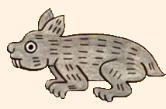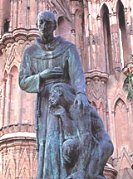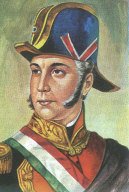|
The History of San Miguel de AllendeA Rich Past Still Visible TodayD on't know much about history...? OK, I'll tell you. But don't worry. The history of San Miguel de Allende is too fascinating to be boring. Prehispanic PeriodIt all goes back to the Toltecs. They had a ceremonial center called Panoayan where the town of Comonfort is today, about half an hour from San Miguel. Archaeological remains being studied there include a ball court and ceramic findings.
The Toltecs settled mainly along the banks of the Rio Laja, taking advantage of the rich alluvial soil to grow crops and leaving behind many stone tools. But by 1200 A.D, they had moved further south and the ceremonial centers were abandoned. For the next 300 years, the area around San Miguel de Allende saw some nomadic tribes passing through. Groups of Chichimecas began to settle along the river. But mostly the hills just snoozed peacefully in the sunshine. The ConquestAnd then the Spaniards arrived. And where the conquistadores went, the priests were never far behind. And often ahead.The history of San Miguel de Allende made a sharp turn.The first convent in the state was founded at Acámbaro in 1536 by Franciscans from Uruapan. From this convent, a monk name Fray Juan de San Miguel headed up an expedition to explore the area to the north, the land of the Chichimecas. When he arrived at the valley of the Rio Laja, it seemed like a good place to found a mission. The site might have been fine, but the building was not. Its fragile construction led to its disappearance within a very few years. Undaunted, in 1542 the Franciscan priest built the Chapel of San Miguel Archangel at the site now know as San Miguel el Viejo, about a mile from today's centro. Here he celebrated the first Christian ceremony in the region. The real history of San Miguel de Allende is usually dated from that event. Once he had the mission well established, Fray Juan moved on to found others, leaving San Miguel in the capable hands of Fray Bernardo Cossín, with strict instructions to see to the conversion of the Indians to Catholicism. He was also to teach them European farming and weaving techniques.
About this same time, vast veins of silver were discovered at Zacatecas, and heavily loaded mule caravans were soon streaming south, carrying this river of silver to the capital. In 1550, a group of Chichimecas took issue with this invasion of their territory and attacked the village of San Miguel de los Chichimecas (San Miguel el Viejo). 15 people were killed and the village burned to the ground. Fray Bernardo figured he'd better find a safer spot for his flock. The good father led the people up the hill, to the site of today’s Chorro spring. Popular legend says it was actually a thirsty dog that discovered the spring, but Bernardo obviously knew a good thing when he saw it. The site was safer, healthier, and certainly wetter. And so here he began to rebuild the town. And here it stayed. Colonial HeyDayThe area around the Laja River turned out to be wonderful cattle country. The town quickly grew fat and sassy as both Spaniards and indigenous peoples moved up from the south to populate the rich land. It became know as San Miguel el Grande, and by the 1770s it was a wealthy, cosmopolitan city, larger than either New York City or Boston in the U.S.The Forge of IndependenceIn 1779, the prominent Allende family added a member, a son they named Ignacio (hmmm... wonder if the family called him "Nacho" like they would today). With his birth and life, the history of San Miguel de Allende was destined to make it into textbooks throughout Mexico.
Allende was educated at the Colegio de San Francisco de Sales, the building that today faces the Plaza Cívica and a huge bronze statue of the hero himself astride a huge charger. In 1810, he became an officer in the Queen's Dragoons, but it's likely he'd already been infected with the fire of independence. He spent time conspiring with Morelos, Aldama, and other agitators for independence in the House of the Conspirators on Calle Reloj at the corner of the Jardín. On September 16, 1810, the Mexican War of Independence began, with Allende as one of its chief lieutenants. He led the rebels to several military victories and got himself named a hero, but he was captured by the Spanish and beheaded before the war was over. In 1826, in honor of this heroic favorite son, San Miguel was given the name we still use today and christened La Fragua de Independencia, the Forge of Independence. Modern Times in San MiguelFast forward a hundred years. As modernity began to creep in, the city fathers saw the wisdom of protecting what they had. The center of San Miguel was named a National Historic Landmark. The town became popular as a hang-out for Mexican movie stars, famous for its nearby hot springs and its pure air and colonial charm.In 1938, the most prominent American to ever live in San Miguel de Allende arrived. Stirling Dickinson rode into town on a donkey from the bus station on a sunny February day. According to a biography by John Virtue, he looked up at the Parroquia and said "My God, what a sight! I'm going to stay here." He soon became the director of a new art school at Bellas Artes. After World War II, San Miguel was "discovered" yet again, this time by U.S. GIs, who realized their GI benefit checks would stretch a lot farther in Mexico than back home. And San Miguel was the perfect place for many to heal from the horrors—both physical and psychic—of the war. In 1950, the Instituto Allende was formed, with Dickinson as its first director. San Miguel's role as an artists' and writer's colony became firmly established. And so it still is today. In the '60s, the U.S. counterculture arrived with Ken Kesey and the Merry Pranksters. Neal Cassaday died here after falling down drunk on the railroad tracks outside town. In the '70s, hippies drank in La Cucaracha, a famous bar on the corner of the Jardín where Banamex is today. San Miguel TodayToday, an estimated 10,000 foreigners, mostly from the U.S. and Canada, call San Miguel home, making up about 10-12% of the population. They treasure their mountain paradise and enjoy being part of the ongoing history of San Miguel de Allende.Return from History of San Miguel de Allende to About San Miguel BACK to Experience San Miguel HOME |









